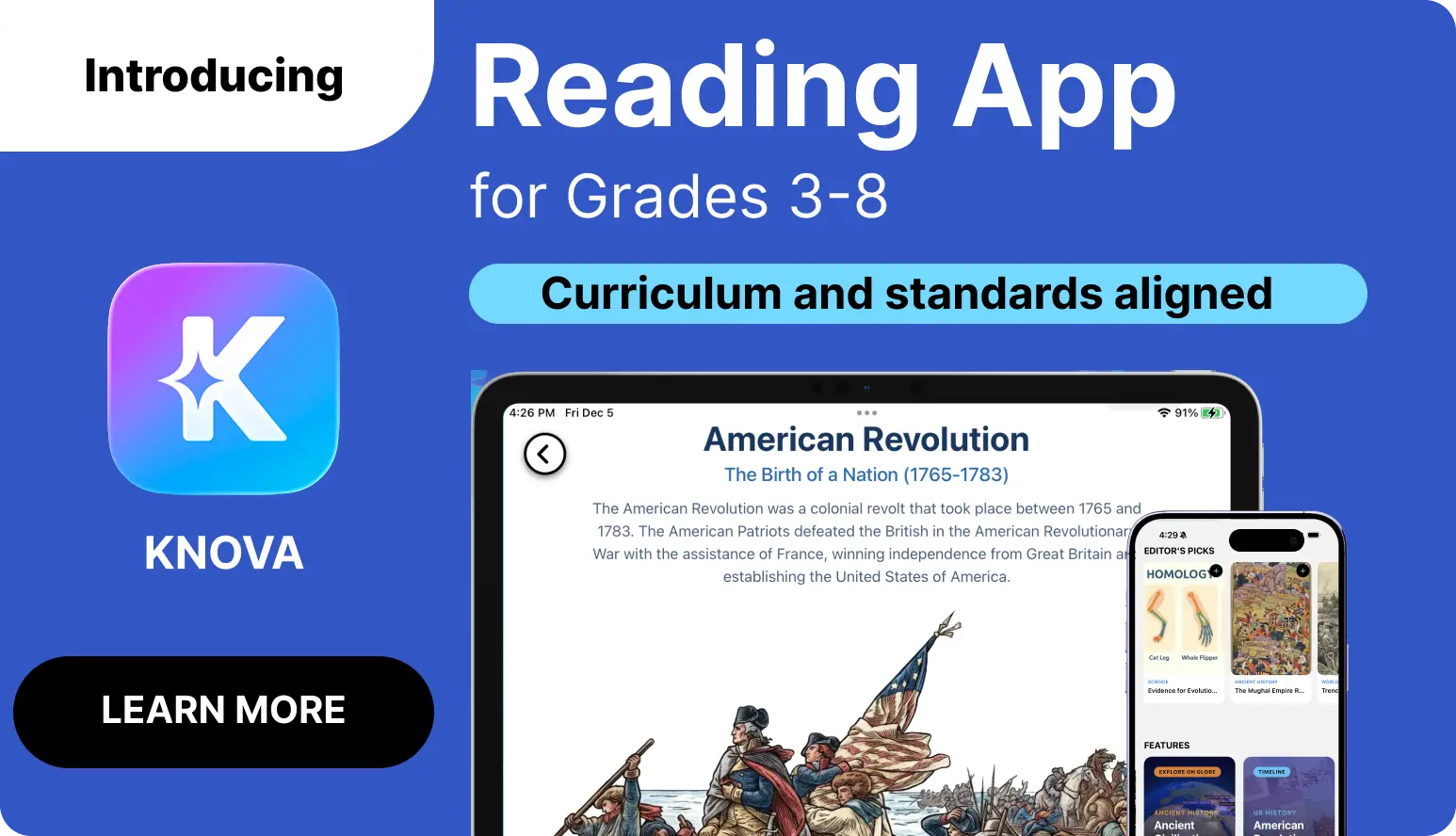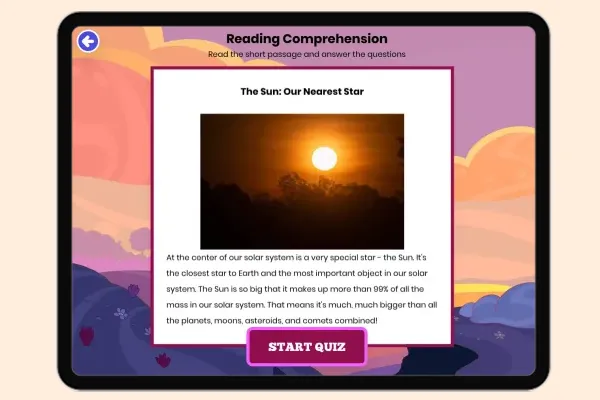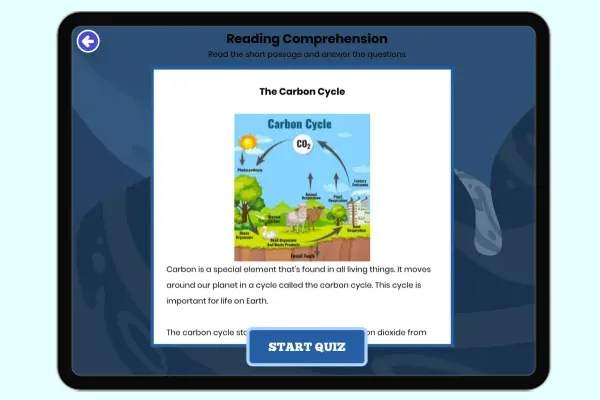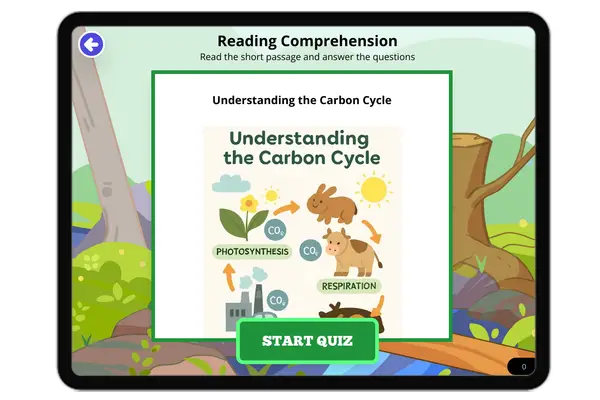Reading Results
The Solar System-Short Story
Join Mia on her science project journey through the solar system. Learn about the eight planets orbiting the Sun, their ...
RL.2.10RL.3.10RL.3.1RL.2.2
Earth Day and Types of Pollution
Earth Day is coming! Get ready to learn about pollution and test your knowledge. Click for a free reading passage and qu...
RI.4.1RI.4.2ESS3.CESS3.A
Earth Day and Green Initiatives
Celebrate Earth Day with this fun and educational activity! Students will begin by reading a short passage that explains...
RI.4.1RI.4.2ESS3.CESS3.A
Sunspots and Solar Flares
This quiz is designed to test your understanding of the fascinating phenomena of sunspots and solar flares, as described...
RI.4.1RI.4.4RI.5.1ESS1.A
Understanding Sunspots
Sunspots are fascinating dark patches on the Sun's surface caused by intense magnetic activity that lowers the temperatu...
How Heat Domes Form
A heat dome is an extreme weather event where high pressure traps hot air in an area, causing temperatures to rise signi...
RI.5.1
Main causes of a heat dome?
Heat domes are caused by specific atmospheric patterns, primarily involving high-pressure systems. These high-pressure a...
RI.5.1
Health Risks of Heat Domes
Heat domes pose significant health risks as our bodies struggle to maintain a safe temperature in extreme heat. Dehydrat...
RI.5.1
Is Earth’s Climate Changing?
The passage 'Is Earth’s Climate Changing?' explores how scientists study Earth's climate through global temperature reco...
Learn about the Inner Planets
The inner planets of our solar system—Mercury, Venus, Earth, and Mars—are fascinating worlds made of rock and metal. Clo...
RI.4.4RI.4.2
The Sun: Our Nearest Star
The Sun is the heart of our solar system and the closest star to Earth. Composed of hot plasma, the Sun generates energy...
RI.4.4RI.4.2
Exploring Space: Rockets and Spacecraft
Space exploration has been one of humanity's greatest achievements, made possible by rockets and spacecraft. Rockets act...
RI.4.4RI.4.2
Understanding the Inner Planets
The inner planets of the solar system—Mercury, Venus, Earth, and Mars—are known for their solid, rocky surfaces. Mercury...
RI.4.4RI.4.2
The Sun: Our Special Star
The Sun is the closest star to Earth and the center of our solar system.
RI.4.4RI.4.2
Twinkling Stars and Galaxies
Learn about stars, the massive balls of gas that produce light and heat, and their life cycles, from birth in nebulas to...
RI.4.4RI.4.2
The Milky Way - Our Galactic Home
The Milky Way is a massive spiral galaxy containing billions of stars, including our Sun. It features a central bulge, s...
RI.4.4RI.4.2
Andromeda - Our Galactic Neighbor
Andromeda, also known as Messier 31, is a massive spiral galaxy with about one trillion stars, located 2.5 million light...
RI.4.4RI.4.2
The Water Cycle
The water cycle describes how water continuously moves through our planet via evaporation, condensation, precipitation, ...
RI.4.4RI.4.2
The Carbon Cycle
The carbon cycle shows how carbon travels through the atmosphere, living organisms, and the Earth. It maintains the bala...
RI.4.4RI.4.2
The Nitrogen Cycle
The nitrogen cycle describes how nitrogen moves through the air, soil, and living organisms. It involves processes like ...
RI.4.4RI.4.2
The Phosphorus Cycle
The phosphorus cycle explains how phosphorus moves through rocks, soil, water, and living things. Essential for DNA and ...
RI.4.4RI.4.2
The Oxygen Cycle
The oxygen cycle illustrates how oxygen moves through the atmosphere, water, and living organisms. Driven by photosynthe...
RI.4.4RI.4.2
Understanding the Carbon Cycle
The carbon cycle explains how carbon moves through the environment, plants, and animals. Processes like photosynthesis a...
RI.4.4RI.4.2
Understanding the Phosphorus Cycle
The phosphorus cycle details how phosphorus travels through rocks, soil, water, and organisms. Essential for DNA and bon...
RI.4.4RI.4.2
Understanding the Oxygen Cycle
The oxygen cycle explains how oxygen circulates through air, water, and living organisms. Plants produce oxygen during p...
RI.4.4RI.4.2
Natural Disaster: Earthquake
Earthquakes occur when tectonic plates move, causing the ground to shake. Understanding earthquakes helps us prepare and...
RI.3.1RI.4.4RI.4.2RI.5.2
Natural Disaster: Volcanic Eruptions
Volcanoes can erupt with lava and ash, changing the landscape. While dangerous, they also create fertile land and new la...
RI.3.1RI.4.4RI.4.2RI.5.2
Natural Disaster: Tornadoes
Tornadoes are dangerous spinning columns of air. Knowing the signs and having safety plans can help protect you from the...
RI.3.1RI.4.4RI.4.2RI.5.2
Natural Disaster: Hurricanes
Hurricanes are massive storms with strong winds and rain. Tracking and preparing for them helps protect people in their ...
RI.3.1RI.4.4RI.4.2RI.5.2
Natural Disaster: Floods
Floods occur when excess water overflows onto land. Knowing how to prepare for and respond to floods can help protect pe...
RI.3.1RI.4.4RI.4.2RI.5.2
Natural Disaster: Droughts
Droughts are long periods with insufficient water, leading to crop failures and water shortages. Conserving water and pl...
RI.3.1RI.4.4RI.4.2RI.5.2
Natural Disaster: Wildfires
Wildfires spread quickly and can cause significant damage. Understanding fire safety and prevention is key to protecting...
RI.3.1RI.4.4RI.4.2RI.5.2
Natural Disaster: Tsunamis
Tsunamis are massive waves caused by underwater disturbances. Early warnings and evacuation plans are crucial to saving ...
RI.3.1RI.4.4RI.4.2RI.5.2
Natural Disaster: Landslides
Landslides occur when masses of rock or debris move down a slope. They can cause massive destruction and can be triggere...
RI.3.1RI.4.4RI.4.2RI.5.2
Natural Disaster: Blizzards
Blizzards are intense winter storms with strong winds and heavy snow. They can create dangerous conditions and require p...
RI.3.1RI.4.4RI.4.2RI.5.2
The Great Barrier Reef
This passage introduces the Great Barrier Reef, a magnificent underwater ecosystem off the coast of Australia. It descri...
RI.3.1RI.4.1
Why the Great Barrier Reef Matters
This passage highlights the critical importance of the Great Barrier Reef for both nature and humans. It emphasizes the ...
RI.3.1RI.4.1
Life in the Great Barrier Reef
This passage delves into the rich biodiversity of the Great Barrier Reef. It describes the vast array of marine life, in...
RI.3.2RI.4.2
Climate Change and the Great Barrier Reef
This passage explores the profound impact of climate change on the Great Barrier Reef. It details how rising ocean tempe...
RI.3.2RI.4.2
How Kids Can Help Protect the Great Barrier Reef
This passage focuses on empowering children to take action in protecting the Great Barrier Reef and the environment. It ...
RI.3.2RI.4.2
Understanding Coral Bleaching
This passage delves into the phenomenon of coral bleaching in the Great Barrier Reef. It explains how rising water tempe...
RI.3.8RI.4.8
Efforts to Save the Great Barrier Reef
This passage outlines various efforts to protect and preserve the Great Barrier Reef in the face of climate change. It d...
RI.3.8RI.4.8
What is Weather?
This passage explains weather to children, describing it as the current outdoor conditions. It covers various weather ty...
RI.3.1RI.4.14.ESS2.D
How is Climate Different from Weather?
This passage distinguishes climate from weather for young readers. It defines climate as the usual weather patterns over...
RI.3.1RI.4.14.ESS2.D
What is the Greenhouse Effect?
This passage introduces the greenhouse effect to children, comparing it to a blanket around Earth. It explains how sunli...
RI.3.1RI.4.14.ESS2.D
Can you name three greenhouse gases?
This passage introduces children to three common greenhouse gases: carbon dioxide (CO2), methane, and water vapor. It ex...
RI.3.1RI.4.14.ESS2.D





















































